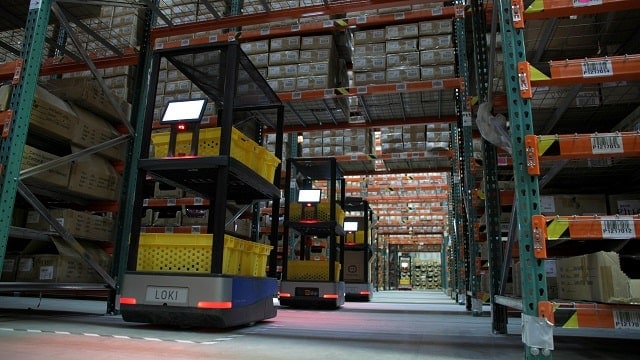Technology is such a constant force for change that we tend to look at new technological innovations as almost normal — or at least par for the course. But the fact remains that technological advances are regularly disruptive to old methods and approaches.
If your business is going to keep pace with its competitors in such a rapidly changing world, it’s going to need to embrace and integrate as much technological innovation as it can.
In e-commerce, fulfillment is the bridge between your product and your customers. Without it, your inventory stays on the shelf, and your customers look elsewhere to get what they need. In a lot of ways, your fulfillment strategy, and the way you execute that strategy, is the sum total of your customer experience.
Therefore, fulfillment is a vital part of a business’s operations.
But just as there are many different businesses and products, each situation requires a different fulfillment strategy. You need proven solutions that can scale, and you need them to be efficient, accurate and reliable.
In this expert’s guide to e-commerce fulfillment, we’ll cover:
- What is e-commerce fulfillment?
- The three main types of fulfillment
- Inventory management techniques
- How automation can help
- The future of e-commerce fulfillment
This guide will primarily look at fulfillment through the e-commerce lens and deal mostly with third-party logistics (3PL) fulfillment methodologies.
What is e-commerce fulfillment?
E-commerce fulfillment has several layers to it. It all centers on customer service — you have a customer online who decided to buy something your business makes or sells. The ecommerce fulfillment process is how it gets from you to your customer. It involves:
- Inventory management
- Receiving
- Warehousing
- Pick and pack
- Shipping
- Returns
Those first three steps involve how the various components of your products — and your customers’ orders — are assembled and readied for picking and shipping.
Picking and packing is the process in which a customer’s order is put together. If they have one item, it’s easy. If they have many items, these will need to be selected from different zones of the warehouse and placed together in a shipping box.
Shipping isn’t as easy as it might sound. Some items can and should be sent through parcel delivery services (typically for B2C shipments, but not always). Other items that are heavy or bulky must be shipped via freight, and that requires access to a whole different network of specialists.
The last step, returns, is not often well-enough integrated into many small businesses’ fulfillment strategies. If products are damaged, whether in transit or not, or if the wrong item was shipped, you need to have a way to deal with the discrepancy properly. That means implementing a returns putaway process as well as a process for disposing of, recycling, or refurbishing products that can’t be resold in their current state.
This capacity isn’t just about customer service, either — it’s about inventory management. You need a process that focuses on returns for inspections, confirmations and restocking because any inventory that’s unaccounted for can’t serve your business. With a documented returns process in place, you can recover the value of returns quickly.
When you sell your goods online, it’s not the same as a location-based, brick-and-mortar customer experience. By doing away with a physical location, you’ve given up the possibility of providing a face-to-face customer experience. The customer experience now hinges entirely on how flawlessly your e-commerce fulfillment strategy works.
The three main types of e-commerce fulfillment

There are three primary strategies in the fulfillment business:
- In-house
- Drop shipping
- 3PL
1. In-House Fulfillment
In-house fulfillment or self-fulfillment is the strategy that requires you to keep all fulfillment tasks and responsibilities under your own company’s roof (or under your company’s direct management and control). It’s great for startups and small businesses, but it can be difficult to scale.
2. Drop Shipping
If you decide to build your fulfillment strategy around drop shipping, you won’t stock products in a warehouse. Instead, you will effectively sell another company’s products to your customers via your e-commerce store, while the drop shipping company manages both warehousing and shipping for you.
The upside is that you don’t need to fret about order fulfillment. This approach may be a good option for small businesses or entrepreneurs first getting into the e-commerce space. It can also be a viable strategy for growing e-commerce businesses that want to expand their product lines to offer more SKUs but don’t have the capacity to keep fulfillment tasks in-house.
3. 3PL
The 3PL model involves outsourcing your fulfillment to a third-party logistics specialist. This company will manage your warehousing, packaging and shipping. With a 3PL strategy, you can provide your customers with a fully integrated experience from checkout to delivery (and returns).
Inventory management techniques
Inventory management covers everything from ordering and storing materials, parts, and products to how you move your inventory throughout your warehouse, how you track it, and how efficient the whole process is. Naturally, this procedure invites all manner of disciplines as companies strive to find the best solution for their own challenges.
It used to be perfectly adequate to use a written ledger and a pencil to track warehouse inventories. Then again, it also used to be just fine to spend way too much time picking and packing orders manually. If you want to compete with e-commerce’s movers and shakers, you need a better way to get things done.
And these days, there isn’t just one way to get the job done. What’s right for one operation could be dead wrong for another. This introduces the need for customized solutions. Let’s delve into some of the most common inventory management techniques.
Bulk management
Conventional wisdom says that it’s least expensive to work in bulk, whether you’re talking about purchasing or shipping. And for the most part, this is true — although not always.
If you’re dealing in high-demand commodities like copper, building materials, minerals (such as salt), or consumables, the bulk technique of inventory management is best. Bulk management can also be used to provide zones within your warehouse for staging large quantities of non-commodity items, whether inbound or outbound.
The point is that bulk management isn’t just for commodities; it’s better thought of as a management technique for large quantities of inventory. The petroleum, building and food industries effectively put this principle to work. The biggest and best have scaled it to a global level, and their practices are worth studying for insights.
Know before you commit, though, that going bulk will require a lot of warehouse space, and the longer your inventory sits, the more it will cost you.
ABC inventory management
The ABC inventory management technique involves assigning a priority to a particular item or class of items so that they can be expedited. Usually, the criteria are threefold:
- Annual units sold
- Inventory value
- Cost significance
With this method, it’s possible to forecast, to a certain point, how items in your inventory are performing relative to others. It’s also possible to adjust pricing based on these performance indicators.
However, this method often misses the first indications when an item or class of items begins to trend upward, which could lead to understocking and missed opportunities.
Backordering
This technique can be risky. If you enable backordering, you don’t have physical products on hand, yet you’re still taking payment for it. You’re leveraging the time value of money, among other things, in order to bank revenues so that you can shift production when possible.
Fulfilling all backorders at once could have certain efficiency advantages, but you’re taking customers’ money and goodwill in exchange for a promise. Don’t keep them waiting long.
JIT (Just in Time)
Pioneered most notably in the automotive industry in the turbulent 1970s, the just-in time-inventory technique is extremely efficient because of its inherent leanness, but it tends to create completely unforeseen problems.
If all of your necessary raw materials are unloaded one truck at a time every couple of hours — and one shows up late because of a traffic snarl — you may not be able to process customer orders due to something as seemingly insignificant as a random motorist’s flat tire.
JIT can also fail when it comes up against global supply chain disruptions. For instance, the pandemic of 2020 left many parts of the supply chain reeling from unprecedented shortages caused by either total or rolling shutdowns, depending on the industry. The automotive computer chip shortage is a well-known example of how disruptive it can be when one piece of the JIT chain fails.
Consignment
With consignment, you’re basically using a retailer’s floor space as warehousing. The benefit to the retailer comes from not having to tie up cash flow in inventory. It’s a great way for producers to test new products. But the downside is that your products enter a kind of limbo. If they’re returned unsold, you’re paying for shipping twice.
Cross-docking
A close relative of the JIT technique, cross-docking means all you’re doing is sorting the cargo of one truck into another. Even on the dock, the freight is never not in transit.
The best example of this technique in action can be seen in firms like UPS and FedEx. An inbound trailer bumps the dock and is unloaded and sorted on the dock into three or four disparate outbound trailers, which are loaded and released immediately.
Inventory cycle counting
This technique works best when implemented in conjunction with other methods. The idea behind it is to increase efficiency and decrease downtime by not performing a full inventory reconciliation (or stock check) unless you absolutely must. Inventory cycle counting is a random sample of stock taken on a random basis. There are three primary ways it can be used:
- The control group technique counts the same items often in a short timeframe.
- The random sample technique attempts to spread count activities throughout the inventory in the warehouse so that disruptions are minimized.
- The ABC cycle count technique counts high-priority items more often than those with lower priorities.
In reality, the best inventory management technique for your eCommerce business will likely blend all these techniques to some extent, and could even integrate others, such as a year-end audit.
How automation helps

Given the various wrinkles in the space between you and your customers, it can be difficult to know how to best unravel everything into something that works well for you. After all, one of your primary goals is to ensure customer satisfaction and reduce risk. Because without customers, your bottom line suffers, and you don’t really have a business.
The dream is to find a solution that allows you to do the job better than your competitors and, if possible, anticipate what’s required of you in every aspect of the transaction. Little efficiencies gained here and there add up to huge advantages.
Warehouse automation can help, especially when it’s enhanced with AI. Here are just a few ways autonomous mobile robots are taking warehouse logistics to the next level:
- They’re flexible, optimized and easily scalable.
- They offer improved productivity in the warehouse.
- Onboarding and training can be streamlined.
- Data analysis gives a much better picture of inventory and efficiency metrics.
- Decisions are systematically directed by intelligence, not guesswork.
- Exponential improvements over unaided workflows lead to rapid ROI.
Let’s take a closer look at these advantages.
Optimization and scalability
When AMRs (Autonomous Mobile Robots) are deployed into the warehouse, all kinds of hidden efficiencies can be realized. Since the software that guides each AMR is able to “see” every order as well as the position of every other AMR, it is possible to gain greater efficiencies through system directed workflows.
For instance, instead of picking an individual order until it’s filled, AMRs can direct an associate efficiently, fulfilling multiple orders at once. Instead of pushing a cart through every aisle on the hunt for items, associates can now stay in a zone, picking onto AMRs as directed. This means less walking for people and more efficiency for picking.
Additionally, these solutions are easily scalable. If you need more capacity, simply add more AMRs to the mix. And since the whole process is guided by the AMRs as they move through each zone, it’s quick and easy to train new staff.
Improved productivity
When people spend less time figuring out each customer order, trying to remember where each given item is, and roving the entire warehouse trying to pick one order, it results in a significant increase in productivity and efficiency.
Improved productivity means you’re getting a whole lot more for your money. By employing AMRs, you let the AI choose the most efficient way to pick customer orders. Not only are your employees more efficient because they’re following the system, but your system responds in real-time as orders stack up. This is crucial when high throughput needs to be maximized, such as during peak seasons or make-or-break moments like Black Friday and Cyber Monday (BFCM).
Streamlined employee training processes
If the worker’s tasks are simplified, onboarding is easier too. Imagine how much time it would take a new hire to get their feet under them if they had to memorize, even roughly, your entire warehouse. Then imagine how easy it would be to simply allow an AMR to guide them to their next pick.
The hefty average cost for onboarding one new hire in 2022 is $4,125. Therefore, anything that can be done to streamline employee training is a boon to your bottom line. AMRs enable huge gains in onboarding efficiencies just by performing their everyday functions.
Data analysis
With automation comes data, but you have to know how to use it for it to actually mean anything. Data integration is crucial. It’s not that you have the data; it’s what you can do with those data. A great deal of anxiety and busy work in management strategies will disappear when you have proper data integration.
You won’t have to worry about whether cross-docking will work or if an ABC inventory cycle count will be adequate when you have good, hard data. Mispicks and inaccurate inventory counts will be reduced if the whole process is automated.
Plus, since AMRs are guided by AI, you’ll get real-time, actionable feedback about areas in the warehouse that suffer congestion, and you can proactively troubleshoot ways that you can alleviate the problem.
Decisions guided by intelligence
Instead of guesswork, your decisions will be highly data-driven. You won’t need to wonder which item is selling best right now or has for the last six months or year-to-date — you’ll know. No longer will you need to worry about whether you have a clear picture of your inventory, either, or hope that you have enough stock to cover a trending item.
Since every move made in your warehouse can be tracked and analyzed by your WMS (warehouse management software), and since every component of every order shows up in the system, you can easily track what’s selling and what’s not. And that means you can pivot to what matters when it makes the most difference.
Fast ROI
Since warehouse automation adds efficiency to your entire operation — from inventory accuracy to staffing to picking errors and everything in between — it won’t be long before automation pays for itself.
Your return on investment probably won’t just come in the form of efficiencies gained but also in the form of growth enabled. And if anything, that means you’ll have an edge on your competition.
The future of e-commerce fulfillment
Fulfillment logistics technologies in e-commerce tend to move quickly. It’s those who fail to capitalize on today’s potential advantages who will be left behind, and sooner than later.
The e-commerce landscape is dotted with the wreckage of those who tried but failed to innovate in time and were eliminated.
What are you missing that could make a difference in fulfillment efficiency? Have you considered how AMRs and the automation they bring could increase margins, decrease loss from mismanagement, and bring more market share to your corporation by increasing your agility in the marketplace?
In the end, there’s really only one conclusion: fulfillment is a primary example of a business task that’s begging to be automated. When your warehouse is automated, it is:
- More efficient
- Highly accurate
- Data-rich
- Easily scalable
In the end, automation gives you an edge over your competition. And that’s priceless.


